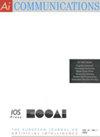DL-PCN:用于动作识别的差分学习和并行卷积网络
IF 1.4
4区 计算机科学
Q4 COMPUTER SCIENCE, ARTIFICIAL INTELLIGENCE
引用次数: 0
摘要
图卷积网络(GCN)算法极大地提高了基于骨骼的人体动作识别的准确性。GCN比其他深度学习算法能更好地利用后续帧中骨骼关节间的空间信息,有利于实现较高的准确率。然而,传统的GCN算法对于多个主GCN层的堆栈需要消耗大量的计算量。为了解决这一问题,我们引入了一种轻量级网络——差分学习与并行卷积网络(DL-PCN),其关键模块是差分学习(DLM)和并行卷积网络(PCN)。DLM具有前馈连接的特点,它携带了具有相同结构的GCN模块的错误信息,其中GCN和CNN模块直接从输入数据中提取原始信息,使得这些模块提取的时空信息比GCN和CNN串联结构提取的时空信息更完整。PCN由GCN和卷积神经网络(CNN)并行组成。在考虑精度和计算参数的情况下,我们的网络在NTU RGB+D 60数据集、NTU RGB+D 120数据集和西北加州大学洛杉矶分校数据集上取得了相当的性能。本文章由计算机程序翻译,如有差异,请以英文原文为准。
DL-PCN: Differential learning and parallel convolutional network for action recognition
Graph Convolution Network (GCN) algorithms have greatly improved the accuracy of skeleton-based human action recognition. GCN can utilize the spatial information between skeletal joints in subsequent frames better than other deep learning algorithms, which is beneficial for achieving high accuracy. However, the traditional GCN algorithms consume lots of computation for the stack of multiple primary GCN layers. Aiming at solving the problem, we introduce a lightweight network, a Differential Learning and Parallel Convolutional Networks (DL-PCN), whose key modules are Differential Learning (DLM) and the Parallel Convolutional Network (PCN). DLM features a feedforward connection, which carries the error information of GCN modules with the same structure, where GCN and CNN modules directly extract the original information from the input data, making the spatiotemporal information extracted by these modules more complete than that of GCN and CNN tandem structure. PCN comprises GCN and Convolution Neural Network (CNN) in parallel. Our network achieves comparable performance on the NTU RGB+D 60 dataset, the NTU RGB+D 120 dataset and the Northwestern-UCLA dataset while considering both accuracy and calculation parameters.
求助全文
通过发布文献求助,成功后即可免费获取论文全文。
去求助
来源期刊

AI Communications
工程技术-计算机:人工智能
CiteScore
2.30
自引率
12.50%
发文量
34
审稿时长
4.5 months
期刊介绍:
AI Communications is a journal on artificial intelligence (AI) which has a close relationship to EurAI (European Association for Artificial Intelligence, formerly ECCAI). It covers the whole AI community: Scientific institutions as well as commercial and industrial companies.
AI Communications aims to enhance contacts and information exchange between AI researchers and developers, and to provide supranational information to those concerned with AI and advanced information processing. AI Communications publishes refereed articles concerning scientific and technical AI procedures, provided they are of sufficient interest to a large readership of both scientific and practical background. In addition it contains high-level background material, both at the technical level as well as the level of opinions, policies and news.
 求助内容:
求助内容: 应助结果提醒方式:
应助结果提醒方式:


